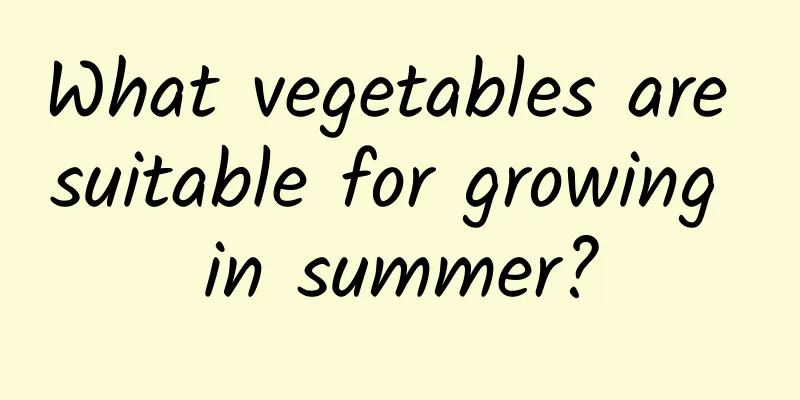What vegetables are suitable for growing in summer?

|
Summer is suitable for growing disease-resistant, heat-resistant and high-yielding vegetables, such as radish, spinach, lettuce, leek, Chinese cabbage, cabbage, rapeseed, chrysanthemum, chicken feather vegetable, wood ear vegetable, amaranth, cucumber, lettuce, cowpea, green beans, etc. 1. Cucumber Cucumbers like warmth and are not resistant to low temperatures. The suitable growth temperature is 20-25℃. Excellent varieties can grow normally in a high temperature of 35 degrees, and photosynthesis is not affected. If there is continuous high temperature and drought weather, appropriate watering is needed to keep the soil moist. 2. Chinese Cabbage Chinese cabbage is suitable for planting in early to mid-August, with a growing period of about 60 days. It can be harvested in October. The planting of Chinese cabbage is relatively complicated. Seedlings must be raised in advance and then planted at a spacing of about 50 cm. Pay attention to weeding and disease prevention during the growth period. 3. Chrysanthemum Chrysanthemum chrysanthemum has few diseases and pests, and its growing period is short, so it is suitable for planting in summer. It can be sown when the temperature is above 20℃. It can be broadcasted or sown in rows. Cover with 1 cm of soil after sowing. The growing period is 35-45 days. It can be harvested when the plant height is 15-20 cm, or you can pinch the young stems and wait for the second harvest. 4. Radish Radishes grow relatively fast and are a type of fast-growing vegetables. Six-leaf radishes are sown in early August, usually in rows. They will emerge in about 4-5 days and can be transplanted with a spacing of 8-10 cm between them. A small amount of fertilizer is applied to keep the soil moist and they can be harvested at the end of September. Tips for growing vegetables in summer1. Improve the soil: Usually, when farmers grow vegetables in summer, they will find that the leaves of the vegetables turn yellow and become smaller. This is actually due to soil salinization. The soil can be improved by applying microbial agents and using organic nutrients such as chitin, alginate, and amino acids. 2. Prevent sunscald: Sunscald is a common phenomenon in which vegetables are damaged by high temperatures. You can prevent it by blocking light, or watering the vegetables in time when water evaporation is large, or supplementing trace elements in time to avoid physiological diseases of vegetables due to calcium deficiency after a long period of cloudy weather. 3. Ensure water supply balance: When growing vegetables in summer, it is easy to have water supply imbalance problems, which will cause the vegetables to wilt. Therefore, farmers should do a good job of root care in daily management, ensure balanced nutrition, water appropriately, and also add alginate, amino acids, etc. to improve the heat resistance of the plants. |
<<: What vegetables are best to grow in May?
>>: What vegetables are suitable for planting in June?
Recommend
How to water Bear's Paw in winter
Watering Bear's Paw in Winter Bear's Paw ...
What kind of plant is dog club and how to grow it?
1. What is the plant? Dog club is actually anothe...
Gardenia blooms several times a year. What should I do if it doesn’t bloom?
1. How many times a year Large gardenias usually ...
How long does it usually take for Mao Hanni to adapt to the basin?
Mao Hanni acclimatization time If the Maohanni Ja...
What is expansive soil?
Expansive soil, also known as bentonite and swell...
Apply this to the rotten flowers, and they will be revived immediately, coming back to life and blooming!
If the roots of succulent plants have black rot, ...
When is the best time to take cuttings of camellia (the fastest way to take root and survive with cuttings of camellia)
When is the best time for camellia cuttings to su...
White butterfly cutting cultivation method
Breeding time White butterfly can be propagated b...
How to water Hawaiian coconut trees
1. Watering after initial planting: This plant li...
Cultivation methods and precautions of Photinia fraseri
1. Soil The soil suitable for the plant to grow i...
How many years does it take for the ugly monster to bear fruit?
Introduction to Planting Ugly Monsters The ugly m...
How do osmanthus trees overwinter in the north?
Osmanthus trees have a certain degree of cold res...
How to plant eggplant seeds? Simple seedling raising method
Eggplant seed planting time Eggplant seeds are ge...
I have 3 pots of flowers at home. Not only are they beautiful and easy to grow, they can also bring good luck!
Huahua grows three kinds of flowers at home: hone...
Is it easy to grow honeysuckle in potted plants at home? (Cultivation and precautions of honeysuckle flower potted plants)
There is no problem in growing honeysuckle in pot...









